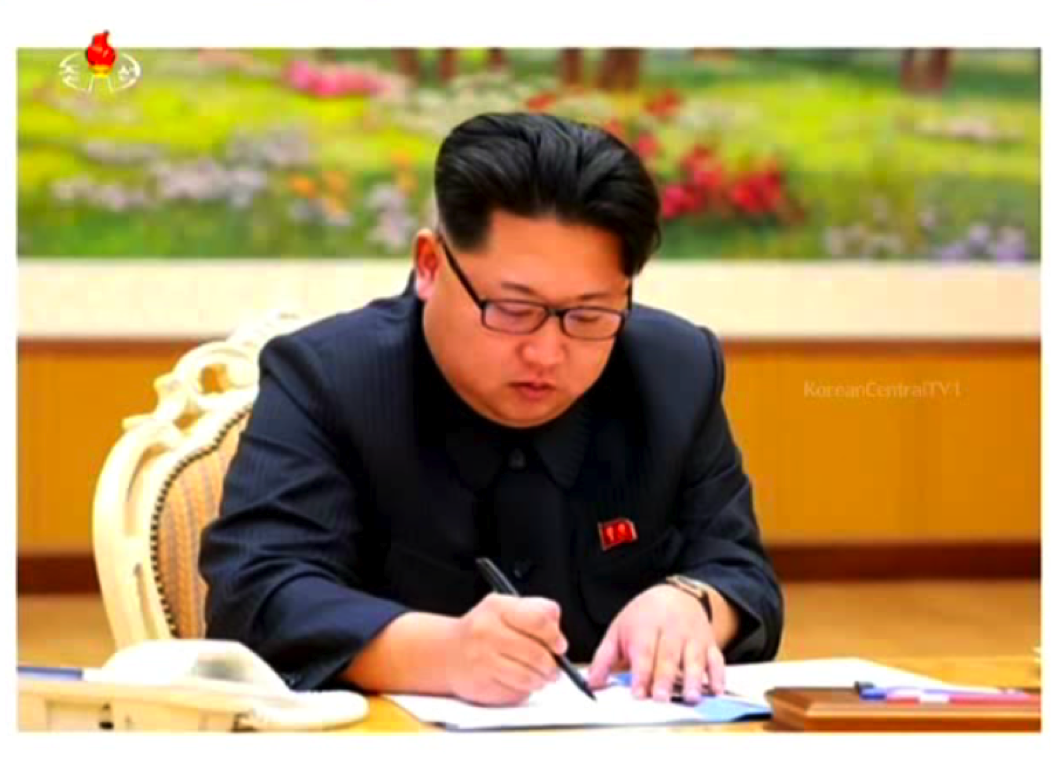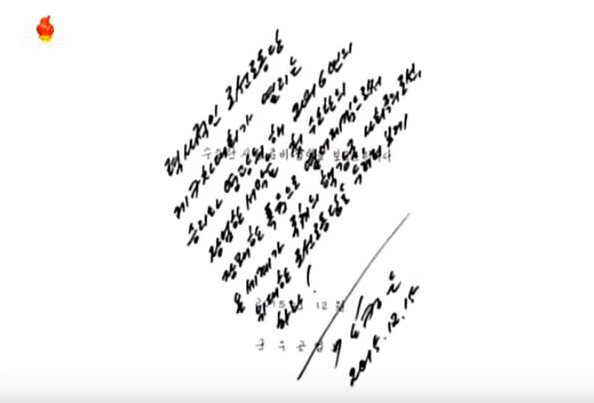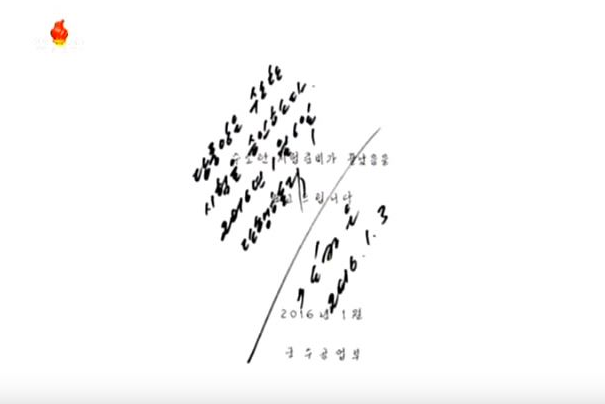KCTV has released images of the cover pages of two documents relating to the test, both of which have instructions written by Kim Jong Un. One of our GRA’s, the multitalented Bo Kim, translated the cover page and Kim’s instructions.
It’s interesting to see an original DPRK document, even if its just the cover. And Kim’s handwriting. Have at ’em.
Update | Stephan Haggard has posted alternate translations which are useful for comparison.
This first document is from December 2015. The cover page reads:
Status of the hydrogen bomb test preparations.
December 2015
Logistics Command
Across it, Kim has written:
“The commencement of the historic 7th Congress of the Korean Worker’s party
and the thrilling explosion of our hydrogen bomb’s magnificent debut
begins the glorious 2016th year.
The nuclear powers of the Juche and social republic Chosun will make
the world look up to the Korean Worker’s Party.
_____________
Kim Jong Un
12/15/2015″
The second document is from January 2016. The cover page reads:
Preparations for the hydrogen bomb test are complete.
January 2016
Logistics Command
Across it, Kim has written:
“The Central Party approves the hydrogen bomb test.
It will be carried out on January 6, 2016.
_____________
Kim Jong Un
1/3/2016″
There are some interesting aspects to these documents that I have noticed. Apparently the “Juche year” is not used internally. You may notice other things. I am certainly eager to hear comments on the translation, which omits some Korean formalities.




Huh.
Curious to know how the Korean language deals with the term ‘hydrogen bomb’ – which is a colloquial term in English. Seeing as a tritium/deuterium-boosted single-stage fission device seems a lot more likely than an actual H-bomb, could the term in Korean refer to that? Or would a writer in Korean understand ‘hydrogen bomb’ to mean a two-stage thermonuclear device?
Hi Mr. Gilchrist,
Thank you for your thoughtful comment. In response, yes, a Korean writer would understand that a hydrogen bomb is a multi-stage fission/fusion weapon. There are separate Korean terms for hydrogen bombs, atomic bombs, nuclear weapons, and boosted fission devices. There are even specific terms to denote the type of reaction, such as “nuclear fusion device.” The only lumped terms are ‘thermonuclear weapon’ and it’s colloquial ‘h-bomb,’ which is the same word in Korean.
I believe the term ‘h-bomb’ in this note does not in some cryptic fashion suggest or imply a boosted single-stage fission device. There is a translation equivalent for each of those words, and the term used in KJU’s note is ‘hydrogen bomb.’ After cross-referencing multiple sources, including the KCNA translation, the text itself does not seem to have any subtle references from either the Logistics Command or KJU of the test being anything besides a thermonuclear device (however debatable the reality).
I speculated that the DPRK government and state media might have used the term “hydrogen bomb [ 水素彈]” as a colloquial term for a “boosted fission bomb” [http://www.nknews.org/2016/01/did-the-kim-regime-exaggerate-n-koreas-nuclear-capability/]. However, on 7 January, the Rodong Sinmun published an article on page 3, ““수소탄과 그 위력 [The Power of a Hydrogen Bomb]” making it very clear that references to “hydrogen bomb [ 水素彈]” mean “nuclear fusion bomb [核融合爆彈].”
Good stuff – thanks very much for the reply.
I draw the conclusion from the early seismic data that It was almost certainly not a successful staged thermonuclear weapon (because it is only rational if you are going to sabre rattle to demonstrate a larger seismic signature that matches a thermonuclear weapon).
What I find interesting is that (assuming it was not a failure of the second stage) that the weapon’s developer knew that this is not classified as a hydrogen bomb, yet they told the Dear Leader as we can see from this document it was a hydrogen bomb. Seems risky in Junche society to overstate your bomb to the boss.
It really depends on what they were testing. Clearly this wasn’t a full scale staged device, but yet another fission device test with (probably) thermonuclear aspects. It may have been purely an attempt to get ignition of thermonuclear fuel, or possibly they were experimenting with boosting to miniaturize their design. There are several legitimately thermonuclear aspects to weapons design that may not result in huge holes in the ground.
Yeah, it’s not likely a real H-bomb. I just wonder if this is an intentional lie, or if it’s more of a translation error (both from Korean to English, and the frequently terrible double transition from technical to politician-speak to journalese). Boosting a single-stage fission device with tritium/deuterium seems a perfectly reasonable next-stage development, and it also seems reasonable to mention the use of hydrogen to differentiate it from the previous weapon tests, which could easily be misunderstood.
“We used isotopes of hydrogen to boost the device” -> “This is different to the last test because we’re using hydrogen to boost it” -> “hydrogen bomb”.
I’ve spent a lot of my working life translating technical information into something politicians can say in a press conference, and hence to something folk at home will understand in a sound bite, and although this could easily be an intentional lie, it could also be a classic example of a failure of that sort of miscommunication. I remember several times when “gram positive” was translated as “positive for anthrax”, and where “contains bacillus cereus” was translated as “contains a biological agent”, which further blew out to “biological attack”.
As per an answer above: nope, it definitely refers to an H-bomb.
What I find interesting …is that USGS initially measured it as a 5.1 Richter Scale earthquake at 10 Km depth…but a day later changed the depth measurement to 0km… ???
Jeffrey, if there is any doubt about the accuracy of my comment due to my not providing a source, here is the excerpt and the source link…
“Word of the nuclear test emerged shortly after 9 a.m. SIN/HK, when the U.S. Geological Survey said it had detected a magnitude 5.1 earthquake about 49 kilometers (30 miles) a known North Korean nuclear test site, according to its coordinates. The USGS said that the earthquake, near the site called Punggye-ri, was about 10 km below the Earth’s surface. ”
http://www.cnbc.com/2016/01/05/big-earthquake-detected-near-north-korean-nuclear-site-reports.html
There was no doubt about your comment; I just didn’t see it was stuck in the queue.
For those desiring perspective, the US “H” bomb was a structure that weighed 82 tons. Useful details are contained in Ken Ford’s fascinating book, “Building the H Bomb–a Personal History,” available at Amazon. He is available on the Internet.
What, he didn’t scribble “Let freedom ring!”?
Perhaps the Dear Leader understood full well that the device being tested was a boosted fission weapon. The American convention that “hydrogen bomb”/”thermonuclear bomb” = staged radiation implosion device seems to me to reflect the history of TN development in the US, in which “hydrogen bomb” = “Super [i.e., megaton yield] bomb.” Why shouldn’t gas-boosted fission weapons, or layer cake/ sloyka devices such as the Soviets tested in 1953, be considered hydrogen bombs, since they use hydrogen isotopes in thermonuclear reactions?